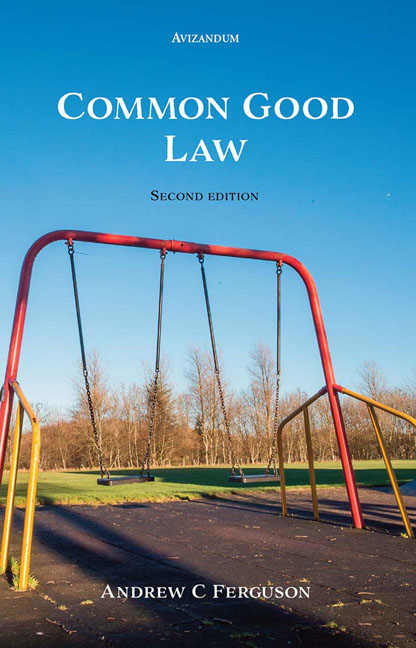Book contents
- Frontmatter
- Contents
- Preface
- Tables of Legislation
- Table of Cases
- 1 Origins and Definitions
- 2 Statutory Framework
- 3 The Administration of the Common Good
- 4 Inalienable Common Good Property
- 5 Classification of Common Good Land
- 6 Appropriation, Alienation and Disposal of Common Good Land
- 7 When Does ‘a Question’ Arise?
- 8 Factors Involved in Allowing Disposal
- 9 Taking a Common Good Case to Court
- 10 Common Good and Community Empowerment
- Appendix I List of Burghs
- Appendix II Disposal, Appropriation and Alienation
- Index
1 - Origins and Definitions
Published online by Cambridge University Press: 20 October 2020
- Frontmatter
- Contents
- Preface
- Tables of Legislation
- Table of Cases
- 1 Origins and Definitions
- 2 Statutory Framework
- 3 The Administration of the Common Good
- 4 Inalienable Common Good Property
- 5 Classification of Common Good Land
- 6 Appropriation, Alienation and Disposal of Common Good Land
- 7 When Does ‘a Question’ Arise?
- 8 Factors Involved in Allowing Disposal
- 9 Taking a Common Good Case to Court
- 10 Common Good and Community Empowerment
- Appendix I List of Burghs
- Appendix II Disposal, Appropriation and Alienation
- Index
Summary
Historical origins of common good
The common good is a fund of money and assets, formerly owned by a burgh and now owned and administered by the local authority for the relevant area.
Although it is administered separately from other local authority funds for accounting purposes, it is owned by the local authority, albeit subject to certain rules relating, in particular, to its disposal. The immediate reason for this separate treatment is to be found in the Local Government (Scotland) Act 1973. However, the roots of common good - and the issues it raises today - stretch back much further.
In its most basic form, common good has its origins in the early Middle Ages, when the ferm toun-a small settlement of interconnected families living in close proximity for mutual protection and support - took a collectivist approach to certain aspects of the farming operation.
The principal feature of this approach was the common muir. Although individuals might have their own strips of land radiating out from the settlement for arable use, it made sense to share grazing land for herd animals. With the advent of the feudal system, this land was often feued out in common for specific purposes. Other essential pertinents, such as peat-cutting rights or land set aside in the centre of the toun for bleaching and drying clothes, were also owned in common.
Distinctions between commonties such as these and common good in its later form are discussed below. However, the common good itself and its development as a legal concept matches its historical development, and in particular the evolution of such simple ferm touns into burghs.
Scottish burghs (derived from the Anglo-Saxon burh) derived from a desire on the part of mediaeval Scotland to develop economically. In the early 1100s, the Scottish kings imported ideas, people and material wholesale from Continental Europe in an effort to modernise and improve the Scottish economy.
David I, in particular, introduced a number of measures which built on the newly arrived feudal system and reflected what he had seen during his time on the Continent.
- Type
- Chapter
- Information
- Common Good Law , pp. 1 - 15Publisher: Edinburgh University PressPrint publication year: 2020



